Marrying Vega and Zen: The AMD Ryzen 5 2400G Review
by Ian Cutress on February 12, 2018 9:00 AM ESTiGPU Gaming Performance, Continued
Rise of the Tomb Raider
One of the most comprehensive games in the gaming benchmark suite is Rise of the Tomb Raider (RoTR), developed by Crystal Dynamics, and the sequel to the popular Tomb Raider which was loved for its automated benchmark mode. But don’t let that fool you: the benchmark mode in RoTR is very much different this time around.
Visually, the previous Tomb Raider pushed realism to the limits with features such as TressFX, and the new RoTR goes one stage further when it comes to graphics fidelity. This leads to an interesting set of requirements in hardware: some sections of the game are typically GPU limited, whereas others with a lot of long-range physics can be CPU limited, depending on how the driver can translate the DirectX 12 workload.

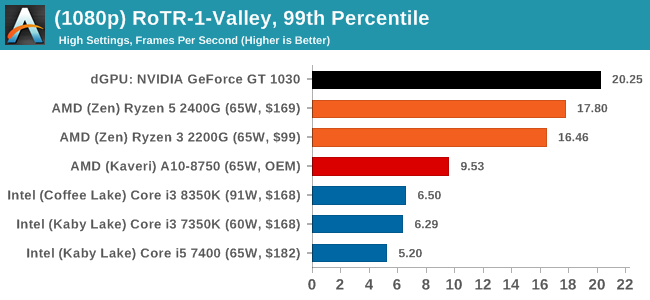
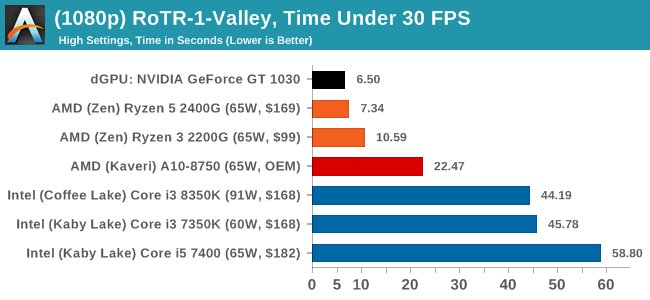
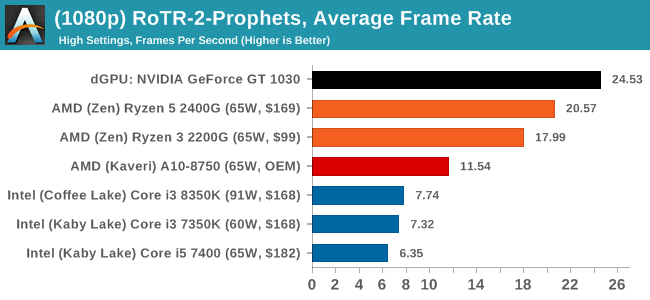
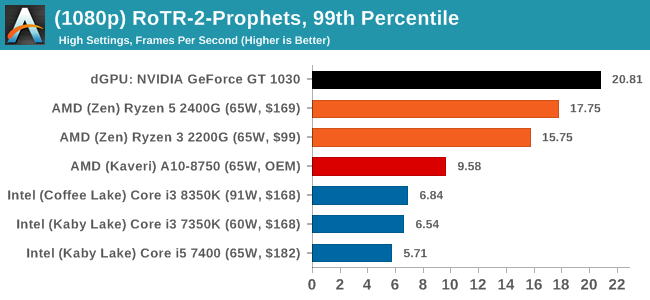
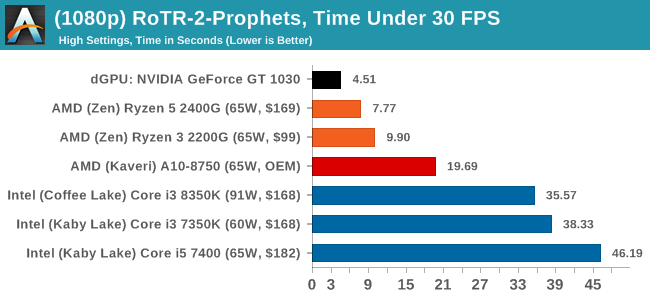

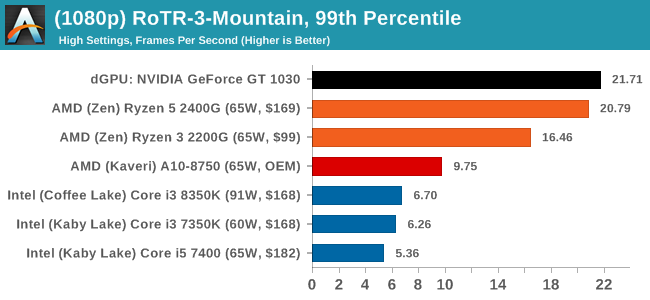
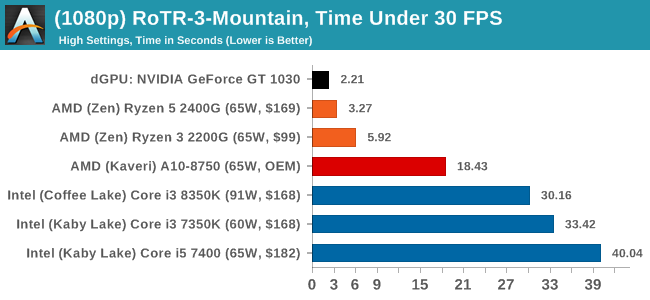
The GT 1030 sweeps the top spot against AMD here, though only by small margins most of the time. The AMD APUs still offer a commanding 2-3x performance jump over Intel's product line, and even more when price is factored into the equation.
Rocket League
Hilariously simple and embodying the elements of pick-up-and-play, Rocket League allows users to jump into a game with other people (or bots) to play football with cars with zero rules. The title is built on Unreal Engine 3, which is somewhat old at this point, but it allows users to run the game on super-low-end systems while still taxing the big ones. Since the release in 2015, it has sold over 5 million copies and seems to be a fixture at LANs and game shows. Users who train get very serious, playing in teams and leagues with very few settings to configure, and everyone is on the same level. Rocket League is quickly becoming one of the favored titles for e-sports tournaments, especially when e-sports contests can be viewed directly from the game interface.
With Rocket League, there is no benchmark mode, so we have to perform a series of automated actions, similar to a racing game having a fixed number of laps. We take the following approach: Using Fraps to record the time taken to show each frame (and the overall frame rates), we use an automation tool to set up a consistent 4v4 bot match on easy, with the system applying a series of inputs throughout the run, such as switching camera angles and driving around.
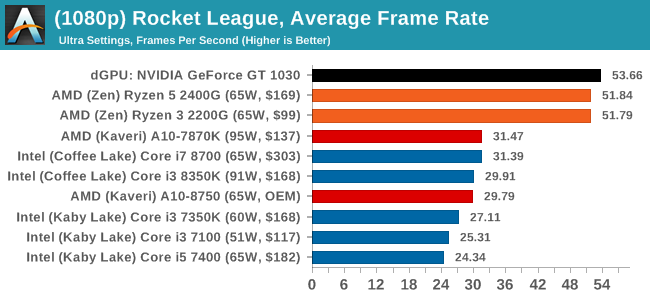
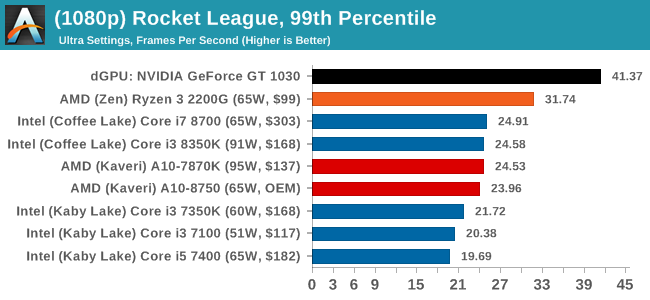

As the more eSports oriented title in our testing, Rocket League is less graphically intense than the others, and by being built on DX9, also tends to benefit from a good single thread performance. The GT 1030 wins again here, most noticably in the 99th percentile numbers, but the AMD chips are hitting 30 FPS in that percentile graph, whereas in the last generation they were getting 30 FPS average. That is a reasonable step up in performance, aided both to the graphics and the high-performance x86 cores. It will be interesting to see how the memory speed changes the results here.










177 Comments
View All Comments
SaturnusDK - Saturday, February 17, 2018 - link
On the subject of allocated VRAM. It should be set as low as possible. The minimum is 64MB. You should never set it higher. Since VRAM is system RAM there is no speed gains to be had in GPU performance setting it higher than the minimum and just letting windows sort out the spill over but you are potentially limiting the CPU performance a lot as allocated VRAM eats available system RAM, so if you have 8GB but set VRAM to 2GB, the system only have 6GB remaining. This can seriously hurt performance in some cases. So, as little VRAM as possible is the correct setting.minidea - Tuesday, February 20, 2018 - link
<p><a href="http://www.minidea.co.in ">Minidea</a></p>Titoboyer24 - Saturday, February 24, 2018 - link
This Is Really A Great Stuff For Sharing. Keep It Up .Thanks For Sharing. <a href="http://www.mechanicalassignments.com/">Mec... Engineering Homework Help</a>Titoboyer24 - Saturday, February 24, 2018 - link
Get The Dissertation Writing Service Students Look For These Days With The Prime Focus Being Creating A Well Researched And Lively Content On Any Topic. Mechanical Engineering Homework Help http://www.mechanicalassignments.com/ ............Titoboyer24 - Saturday, February 24, 2018 - link
Only Professional Writers Can Make This Kind Of Material, Cheers<a href="http://www.spsshelponline.com/">SPSS Homework Help</a>
IntoGraphics - Friday, March 9, 2018 - link
For Ryzen 5 2400G + X370 mATX m/b.What 16GB (4x4GB) and 32GB (4x8GB) kits memory modules (brand + model) would easily overclock much higher than DDR4-2933 for the best GPU performance ?
(I'm looking at some 4000MHz kits but if that is not compatible it will be a waste.)
andrewbaggins - Tuesday, May 1, 2018 - link
Anandtech reviews continue to show us what the graphics chips CAN'T do well instead of what they CAN do well. I've heard all the reasons before, and they don't help. Gaming benchmarks should be presented for PLAYABLE settings rather than can-just-barely-run-it settings, i.e. High/Ultra. No gamer will settle for jerky, stuttery gameplay, so why not show us what the items under review can do on, say, Medium settings with a few High setting benchmarks thrown in for good measure?